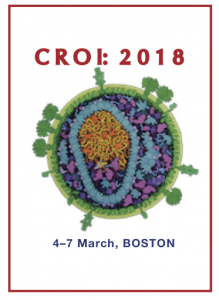Standard dose of dolutegravir sufficient in late pregnancy: interim results from DolPHIN-1 study
30 March 2018. Related: Conference reports, Pregnancy, CROI 25 (Retrovirus) 2018.
 Polly Clayden, HIV i-Base
Polly Clayden, HIV i-Base
As with other published studies, DolPHIN-1 shows standard dose of dolutegravir should be used in the third trimester. But HIV positive women who start ART in late pregnancy are a vulnerable group with a higher risk of adverse outcomes and vertical transmission of HIV.
DolPHIN-1 is a randomised study looking at dolutegravir (DTG) 50 mg + 2NRTIs vs efavirenz (EFV) 600 mg + 2NRTIs (standard of care) in 60 ART-naive pregnant women presenting at 28 to 36 weeks of gestation to routine ante natal clinics in Kampala, Uganda and Cape Town, South Africa. The preliminary findings were shown at CROI 2018. These are from a scheduled interim analysis after the first 16 women delivered, conducted to evaluate safety and ensure that DTG exposure in the third trimester is sufficient.
The study is a collaboration between University of Liverpool, Infectious Disease Institute, Kampala, Uganda, Desmond Tutu HIV Foundation, Cape Town and University of Cape Town.
As women diagnosed with HIV in late pregnancy need to start ART immediately (before laboratory results to determine study eligibility are available), all participants began treatment with standard of care EFV-based ART and were randomised to continue or switch to DTG + 2NRTI at a median of 3 days (range 1 to 8) later.
The primary endpoint was AUC0-24 of DTG in the third trimester and at two weeks postpartum. Secondary endpoints included viral load <50 copies/mL at delivery and safety and tolerability of DTG in the women and infants.
After two weeks on DTG, samples were collected pre-dose and at 0.5, 1, 2, 3, 4, 6, 8 and 24-hours post-dose with the same sampling schedule postpartum.
Of the 16 women who delivered, eight each received DTG and EFV. Median baseline viral load was 4.15 log copies/mL (range 2.43 to 6.07) and this was similar between arms. By days 14 and 28, viral load was undetectable in 5/8 and 4/8 participants receiving DTG, and 1/5 and 2/7 receiving EFV, respectively. At 2-weeks postpartum, viral load was undetectable in 5/6 and 4/7 participants in the respective treatment arms.
There were two virological failures among participants receiving DTG and none EFV. One had no detectable drug in plasma and was non-adherent (17815 copies/mL at day 28), the second had evidence of three class drug resistance (NNRTI, NRTI and protease mutations; 145 copies/mL at day 28). The investigators noted adherence was a problem across both arms.
There was a modest reduction in DTG exposure in the third trimester but the standard 50 mg dose did not need adjustment. The study used data from non-pregnant population in SPRING 1 and SPRING 2 as reference. See Table 1.
Table 1: Dolutegravir PK parameters
| Third trimester
n=7 GM (95% CI) |
Postpartum
n=2 (Both values) |
Reference
(SPRING 1&2) |
|
| Cmax (ng/mL | 2645
(1965 to 3325) |
4224, 4055 | 3670 |
| C24 (ng/mL) | 778
(447 to 1108) |
1211, 603 | 1110 |
| AUC24 (ng.h/mL) | 39415
(28296 to 50534) |
59633, 44305 | 53600 |
Key: AUC: Area under the curve; C: concentration, CI: confidence interval; GM: Geometric mean.
Both regimens were well-tolerated. Four SAEs were reported, two in one participant in the DTG arm and two in the EFV arm. DTG arm: grade 3 elevation in liver function tests (possibly drug related, concomitant herbal medicine); stillbirth (asphyxia from tight cord around the neck, deemed unrelated to study drug). EFV arm: one grade 3 hypertension; one infant with polydactyly.
DolPHIN1 confirms that women who start ART in late pregnancy are a vulnerable group who might have a higher rate of treatment failure.
comment
Women who present late are a very difficult population to reach and recruit into studies – including DolPHIN-1 – and usually have poorer outcomes than those who start ART earlier in pregnancy. These women need extra support and careful management.
DolPHIN-1 completed recruitment in January 2018 and follow up is ongoing.
DolPHIN-2 – which has just begun – will randomise 250 late presenting women 1:1 to either DTG- or EFV-containing ART. The mothers and infants will be followed up from initiation until weaning of the infant or 18-months postpartum (whichever is earlier).
DolPHIN-2 is designed to generate high-quality evidence on the efficacy and safety of DTG to help inform recommendations, and operational guidance on use of DTG in this high-risk scenario.
References
- Waitt C et al. DolPHIN-1: dolutegravir vs efavirenz when initiating treatment in late pregnancy. 25th CROI. Boston. 4–7 March 2018. Poster abstract 807. http://www.croiconference.org/sessions/dolphin-1-dolutegravir-vs-efavirenz-when-initiating-treatment-late-pregnancy (abstract and poster)
- DolPHIN2 website.
https://www.dolphin2.org

